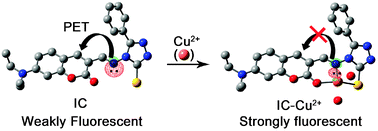Rationally designed fluorescence ‘turn-on’ sensor for Cu2+†
Abstract
A rationally designed,

* Corresponding authors
a
Department of Chemistry, Sungkyunkwan University, Suwon 440-746, Republic of Korea
E-mail:
jinylee@skku.edu
b
Department of Chemistry, Korea University, Seoul 136-701, Republic of Korea
E-mail:
jongskim@korea.ac.kr
c Department of Clinical Laboratory Science, Wonkwang Health Science University, Iksan 570-750, Korea
d Department of Laboratory Medicine, Dankook University Hospital, Cheonan 330-715, Republic of Korea
e Department of Chemistry and Biochemistry, Texas Tech University, Lubbock, Texas 79401, USA
A rationally designed,

 Please wait while we load your content...
Something went wrong. Try again?
Please wait while we load your content...
Something went wrong. Try again?
K. C. Ko, J. Wu, H. J. Kim, P. S. Kwon, J. W. Kim, R. A. Bartsch, J. Y. Lee and J. S. Kim, Chem. Commun., 2011, 47, 3165 DOI: 10.1039/C0CC05421F
To request permission to reproduce material from this article, please go to the Copyright Clearance Center request page.
If you are an author contributing to an RSC publication, you do not need to request permission provided correct acknowledgement is given.
If you are the author of this article, you do not need to request permission to reproduce figures and diagrams provided correct acknowledgement is given. If you want to reproduce the whole article in a third-party publication (excluding your thesis/dissertation for which permission is not required) please go to the Copyright Clearance Center request page.
Read more about how to correctly acknowledge RSC content.
 Fetching data from CrossRef.
Fetching data from CrossRef.
This may take some time to load.
Loading related content
